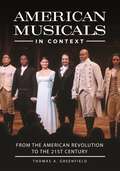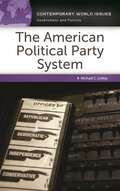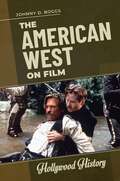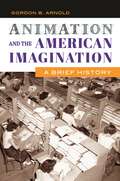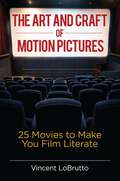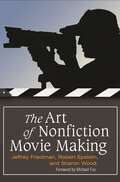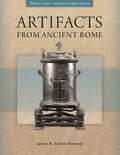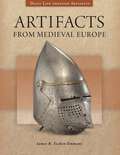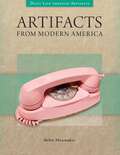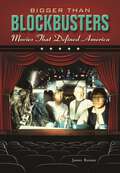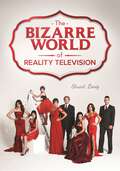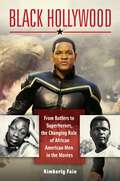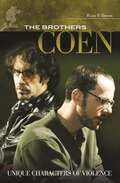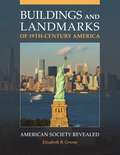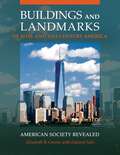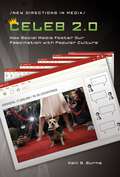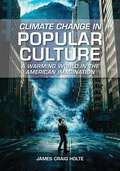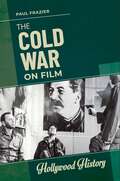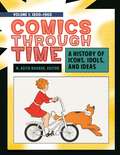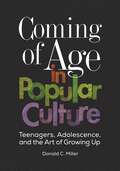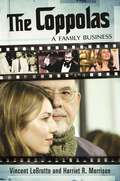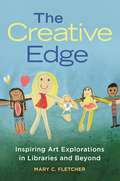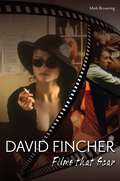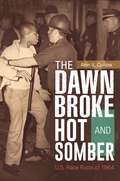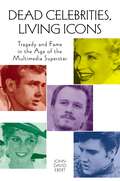- Table View
- List View
American Musicals in Context: From the American Revolution to the 21st Century
by Thomas A. GreenfieldAmerican Musicals in Context: From the American Revolution to the 21st Century gives students a fresh look at history-based musicals, helping readers to understand the American story through one of the country's most celebrated art forms: the musical.With the hit musical Hamilton (2015) captivating audiences and reshaping the way early U.S. history is taught and written about, this book offers insight into an array of musicals that explore U.S. history. The work provides a synopsis, overview of critical and audience reception, and historical context and analysis for each of 20 musicals selected for the unique and illuminating way they present the American story on the stage.Specifically, this volume explores musicals that have centered their themes, characters, and plots on some aspect of America's complex and ever-changing history. Each in its own way helps us rediscover pivotal national crises, key political decisions, defining moral choices, unspeakable and unresolved injustices, important and untold stories, defeats suffered, victories won in the face of monumental adversity, and the sacrifices borne publicly and privately in the process of creating the American narrative, one story at a time. Students will come away from the volume armed with the critical thinking skills necessary to discern fact from fiction in U.S. history.
The American Political Party System: A Reference Handbook (Contemporary World Issues)
by Michael C. LeMayWhat historical factors transformed American politics into the institution we know today? This in-depth look at America's party system traces its efficacy, sustainability, and popularity through six influential presidencies spanning 1790 to the present day.Did President Obama's election serve as the impetus to the development of a seventh political party system? This compelling text sheds light on the American political process as seen through the lens of six pivotal presidencies that shaped America's culture, politics, and society and considers how our current president may be the latest transformative leader in this lineage. Covering two centuries of politics, the work offers insight into the American political machine and reveals how and why the two-party system became so dominant in American politics. Topics include the media's focus on the horse-race aspect of elections, the declining importance of party identification, and the impact of the geographical split that results in swing-states and gerrymandered districts.The work begins by dividing 200 years of politics into 6 periods influenced by a transformative president and discussing the profile of the party system in each era. The next section presents essays contributed by activists across a myriad of political parties and profiles leading political actors and organizations. The final section includes tables, primary source documents, reference lists, a detailed glossary, and a timeline of the development of American political parties that help elucidate the text and show the role political parties have played throughout history.
The American West on Film (Hollywood History)
by Johnny D. BoggsMore than a history of Western movies, The American West on Film intertwines film history, the history of the American West, and American social history into one unique volume.The American West on Film chronicles 12 Hollywood motion pictures that are set in the post–Civil War American West, including The Ox-Bow Incident, Red River, High Noon, The Searchers, The Magnificent Seven, Little Big Man, and Tombstone. Each film overview summarizes the movie's plot, details how the film came to be made, the critical and box-office reactions upon its release, and the history of the time period or actual event. This is followed by a comparison and contrast of the filmmakers' version of history with the facts, as well as an analysis of the film's significance, then and now.Relying on contemporary accounts and historical analysis as well as perspectives from filmmakers, historians, and critics, the author describes what it took to get each movie made and how close to the historical truth the movie actually got. Readers will come away with a better understanding of how movies often reflect the time in which they were made, and how Westerns can offer provocative social commentary hidden beneath old-fashioned "shoot-em-ups."
Animation and the American Imagination: A Brief History
by Gordon B. ArnoldProviding a detailed historical overview of animated film and television in the United States over more than a century, this book examines animation within the U.S. film and television industry as well as in the broader sociocultural context.From the early 1900s onwards, animated cartoons have always had a wide, enthusiastic audience. Not only did viewers delight in seeing drawn images come to life, tell fantastic stories, and depict impossible gags, but animation artists also relished working in a visual art form largely free from the constraints of the real world. This book takes a fresh look at the big picture of U.S. animation, both on and behind the screen. It reveals a range of fascinating animated cartoons and the colorful personalities, technological innovations, cultural influences and political agendas, and shifting audience expectations that shaped not only what appeared on screen but also how audiences reacted to thousands of productions. Animation and the American Imagination: A Brief History presents a concise, unified picture that brings together divergent strands of the story so readers can make sense of the flow of animation history in the United States. The book emphasizes the overall shape of animation history by identifying how key developments emerged from what came before and from the culture at large. It covers the major persons and studios of the various eras; identifies important social factors, including the Great Depression, World War II, the counterculture of the 1960s and 1970s, and the struggles for civil rights and women's rights; addresses the critical role of technological and aesthetic changes; and discusses major works of animation and the responses to them.
The Art and Craft of Motion Pictures: 25 Movies to Make You Film Literate
by Vincent LoBruttoThis volume can rightfully be called "a film school in a single book." Investigating and analyzing the elements and concepts of motion picture creation, this book looks closely at 25 films that represent a wide range of styles and subjects.Although most motion picture viewers have seen numerous movies in their lifetime, few in the general public have a firm and deep understanding of how motion pictures are created, or a grasp of the intricacies of cinematic storytelling and content. By presenting 25 films, American and international, Hollywood and independent, this book educates and enlightens readers about the details of the motion picture creation process.Some readers will have viewed certain films in the volume, but many will be introduced to major cinematic works within the canon of great and essential films for the very first time. Topics explored include animation, period films, editing, directorial style, and non-linear cinematic structure. Readers will learn about the origin of the jump cut in Breathless, time and space in Hiroshima Mon Amour, and the editing in Orson Welles's essay film F is for Fake. The Art and Craft of Motion Pictures: 25 Movies to Make You Film Literate will educate the novice and avid moviegoer alike about the inner workings of this dynamic, popular, and culturally significant art form.
The Art of Nonfiction Movie Making
by Jeffrey Friedman Rob Epstein Sharon WoodThe past few years have featured such blockbusters as Super-Size Me, Fahrenheit 9/11, Sicko, March of the Penguins, and An Inconvenient Truth. And as news articles proclaim a new era in the history of documentary films, more and more new directors are making their first film a nonfiction one. But in addition to posing all of the usual challenges inherent to more standard filmmaking, documentaries also present unique problems that need to be understood from the outset. Where does the idea come from? How do you raise the money? How much money do you need? What visual style is best suited to the story? What are the legal issues involved? And how can a film reach that all-important milestone and find a willing distributor? Epstein, Friedman, and Wood tackle all of these important questions with examples and anecdotes from their own careers. The result is an informative and entertaining guide for those just starting out, and an enlightening read for anyone interested in a behind-the-scenes look at this newly reinvigorated field of film.
Artifacts from Ancient Rome (Daily Life through Artifacts)
by James B. Tschen-EmmonsWhen Roman objects and artifacts are properly analyzed, they serve as valuable primary sources for learning about ancient history. This book provides the guidance and relevant historical context students need to see relics as evidence of long-past events and society.Artifacts from Ancient Rome is a unique social history that explores major aspects of daily life in a long-ago era via images of physical objects and historical information about these items. This book also affords "hands-on training" on how to approach primary sources.The author—a historian also trained as an archaeologist—begins by explaining the concept of using artifacts to understand and "see" the past and providing a primer for effectively analyzing artifacts. Entries on the artifacts follow, with each containing an introduction, a description of the artifact, an explanation of its significance, and a list of further sources of information. Readers of the book will not only gain a composite impression of daily life in ancient Rome through the study of artifacts from domestic life, religion, war, transportation, entertainment, and more, but will also learn how to best understand and analyze primary sources for learning.
Artifacts from Medieval Europe (Daily Life through Artifacts)
by James B. Tschen-EmmonsUsing artifacts as primary sources, this book enables students to comprehensively assess and analyze historic evidence in the context of the medieval period.This new addition to the Daily Life through Artifacts series provides not only the full benefit of a reference work with its comprehensive explanations and primary sources, but also supplies images of the objects, bringing a particular aspect of the medieval world to life. Each entry in Artifacts from Medieval Europe explains and expands upon the cultural significance of the artifact depicted. Artifacts are divided into such thematic categories as domestic life, religion, and transportation. Considered collectively, the various artifacts provide a composite look at daily life in the Middle Ages. Unlike medieval history encyclopedias that feature brief reference entries, this book uses artifacts to examine major aspects of daily life. Each artifact entry features an introduction, a description, an examination of its contextual significance, and a list of further resources. This approach trains students how to best analyze primary sources. General readers with an interest in history will also benefit from this approach to learning that enables a more complete appreciation of past events and circumstances.
Artifacts from Modern America (Daily Life through Artifacts)
by Helen SheumakerThis intriguing book examines how material objects of the 20th century—ranging from articles of clothing to tools and weapons, communication devices, and toys and games—reflect dominant ideas and testify to the ways social change happens.Objects of everyday life tell stories about the ways everyday Americans lived. Some are private or personal things—such as Maidenform brassiere or a pair of patched blue jeans. Some are public by definition, such as the bus Rosa Parks boarded and refused to move back for a white passenger. Some material things or inventions reflect the ways public policy affected the lives of Americans, such as the Enovid birth control pill. An invention like the electric wheelchair benefited both the private and public spheres: it eased the lives of physically disabled individuals, and it played a role in assisting those with disabilities to campaign successfully for broader civil rights.Artifacts from Modern America demonstrates how dozens of the material objects, items, technologies, or inventions of the 20th century serve as a window into a period of history. After an introductory discussion of how to approach material culture—the world of things—to better understand the American past, essays describe objects from the previous century that made a wide-ranging or long-lasting impact. The chapters reflect the ways that communication devices, objects of religious life, household appliances, vehicles, and tools and weapons changed the lives of everyday Americans. Readers will learn how to use material culture in their own research through the book's detailed examples of how interpreting the historical, cultural, and social context of objects can provide a better understanding of the 20th-century experience.
Bigger Than Blockbusters: Movies That Defined America
by James RomanWhether it's the hum drum existence of Marion Crane and her illicit love affair, the psychotic antics of Norman Bates, the sudden irrational migration of birds, a crop duster swooping down on Roger Thornhill in the middle of nowhere, or Vincent Vega and Mia Wallace's unforgettable dance at Jack Rabbit Slim's - they are all cinematic moments that forever changed the psyche and viewing experience of American audiences. Bigger Than Blockbusters: Movies That Defined America tells the stories behind the most significant and influential films in American culture, movies that have had a profound influence on the literary, cinematic and popular culture of our time.Arranged chronologically, the volume gives readers an opportunity to place the films within the context of the social and cultural historic dynamic of the time, making this an ideal source for student papers and reports. Each entry includes the filmmaker, actors, release information, a synopsis of the film, critics' reviews, awards, current availability, and then background on the making of the film in an artistic, economic, and technological context. Spanning all genres, including horror and drama, adventure, comedy, musicals, science fiction, and more, this volume is loaded with enough trivia and factoids to satisfy even the most die-hard movie buff. Also included are other Greatest Films compilations from the National Society of Film Critics and noteworthy sources for comparative purposes. Guaranteed to inspire forays into film favorites as well as some very lively debate, this resource is essential reading for film lovers and students alike.
The Bizarre World of Reality Television
by Stuart LenigHow do reality television programs shape our view of the world and what we perceive as real and normal? This book explores the bizarre and highly controversial world of reality television, including its early history, wide variety of subject matter, and social implications.In recent decades, reality television shows ranging from Keeping up with the Kardashians to Duck Dynasty have become increasingly popular. Why are these "unscripted" programs irresistible to millions of viewers? And what does the nearly universal success of reality shows say about American culture? This book covers more than 100 major and influential reality programs past and present, discussing the origins and past of reality programming, the contemporary social and economic conditions that led to the rise of reality shows, and the ways in which the most successful shows achieve popularity with both male and female demographics or appeal to specific, targeted niche audiences.The text addresses reality TV within five, easy-to-identify content categories: competition shows, relationship/love-interest shows, real people or alternative lifestyle and culture shows, transformation shows, and international programming. By examining modern reality television, a topic of great interest for a wide variety of readers, this book also discusses cultural and social norms in the United States, including materialism, unrealistic beauty ideals, gender roles and stereotypes in society, dynamics of personal relationships, teenage lifestyles and issues, and the branding of people for financial gain and wider viewership.
Black Hollywood: From Butlers to Superheroes, the Changing Role of African American Men in the Movies
by Kimberly FainThis thought-provoking work examines the dehumanizing depictions of black males in the movies since 1910, analyzing images that were once imposed on black men and are now appropriated and manipulated by them.Moving through cinematic history decade by decade since 1910, this important volume explores the appropriation, exploitation, and agency of black performers in Hollywood by looking at the black actors, directors, and producers who have shaped the image of African American males in film. To determine how these archetypes differentiate African American males in the public's subconscious, the book asks probing questions—for example, whether these images are a reflection of society's fears or realistic depictions of a pluralistic America.Even as the work acknowledges the controversial history of black representation in film, it also celebrates the success stories of blacks in the industry. It shows how blacks in Hollywood manipulate degrading stereotypes, gain control, advance their careers, and earn money while making social statements or bringing about changes in culture. It discusses how social activist performers—such as Paul Robeson, Sidney Poitier, Harry Belafonte, and Spike Lee—reflect political and social movements in their movies, and it reviews the interactions between black actors and their white counterparts to analyze how black males express their heritage, individual identity, and social issues through film.
The Brothers Coen: Unique Characters of Violence (Modern Filmmakers)
by Ryan P. DoomThis examination of the distinctive cinema of Joel and Ethan Coen explores the theme of violence in their wide-ranging body of work.The Brothers Coen: Unique Characters of Violence spans the career of the two-time Oscar-winning producer/director team, exploring the theme of violence that runs through a genre-spanning body of work, from the neo-noir of Blood Simple to the brutal comedy Burn After Reading (2008).In chapters focusing on major characters, Ryan Doom looks at the chaotic cinematic universe of the Coens, where violent acts inevitably have devastating, unintended consequences. The remarkable gallery of Coen characters are all here: hardboiled gangster Tom Regan from Miller's Crossing (1990), overmatched amateur kidnapper Jerry Lundergaard from Fargo (1996), accidental private eye "The Dude" from The Big Lebowski (1998), psychopathic assassin-for-hire Anton Chigurh from the 2007 Academy Award winner No Country for Old Men, and more.
Buildings and Landmarks of 19th-Century America: American Society Revealed
by Elizabeth B. GreeneAn invaluable resource for readers interested in architecture and design that demonstrates how the construction, form, and function of key structures in the 19th-century influenced American social, political, economic, and intellectual life.America has always been a nation of thinkers, believers, creators, and builders. Evidence of this is plentiful among the landmarks constructed in the 19th century. Buildings and Landmarks of 19th-Century America: American Society Revealed examines many examples that include homes, office buildings, recreational spaces, military sites, religious buildings, and other landmarks in a variety of geographical locations, discussing the background, architecture, and cultural significance of each. Each engaging, accessible entry not only provides readers detailed information about how the landmark relates to what was going on in American society at the time of its construction but also sparks the reader's interest to research the subject further.As examples, consider that a rural cemetery built in Massachusetts in the early 19th century was the prime influence on public park design and led to the construction of New York's Central Park and many other public parks since. The millionaire industrialist and philanthropist Andrew Carnegie built many of the first free public libraries in the country, which led to the development of municipal public library systems. The huge success of 19th-century world's fairs, like the 1876 Centennial Exhibition and the 1893 World's Columbian Exhibition, had lasting effects on society through the many new products that they introduced to the public. Throughout the book, landmarks are analyzed to elucidate their influence on many aspects of 19th-century society, including the treatment of the mentally ill, impact of religious revivals, growth of leisure and vacation time, and housing for the poor and the western homesteader, among many others.In the "How to Evaluate Buildings and Structures" section, readers are prompted to consider questions such as "What specific purposes did the building or structure have?" "When was it constructed, and what were the circumstances?" and "What was the need it addressed?" Students will learn about the period while also developing the skills of observation and assessment needed to analyze these landmarks and draw meaningful conclusions from them about their context and significance. The discussion of each landmark serves to help readers with these elements of critical thinking, assessment, and analysis.
Buildings and Landmarks of 20th- and 21st-Century America: American Society Revealed
by Elizabeth B. Greene Edward SaloThis engaging book uses buildings and structures as a lens through which to explore various strands of U.S. social history, revealing the connections between architecture and the cultural, economic, and political events before and during these American landmarks' construction.During the 20th and 21st centuries, the United States became the dominant world power. The tumultuous progression of our nation to global leader can be seen in the social, cultural, and political history of the United States over the last century, and the country's evolution is also reflected in major buildings and landmark sites across the nation. Buildings and Landmarks of 20th- and 21st-Century America: American Society Revealed documents how the construction, design, and function of famous buildings and structures can inform our understanding of societies of the past. Its text and images enable readers to get a deeper understanding of the buildings themselves as well as what happened at each structure's location and how those events fit into our nation's history. Through the study of specific buildings or types of buildings that influenced the cultural, social, and political history of the nation, readers will explore monuments to presidents, learn about how the first tract home neighborhoods came into existence, and marvel at the role of buildings in helping us get to the moon, just to mention a few topics.
Celeb 2.0: How Social Media Foster Our Fascination with Popular Culture (New Directions in Media)
by Kelli S. BurnsThis volume looks at how the new capabilities of Web 2.0 are changing the worlds of celebrity fandom and gossip.With Ashton Kutcher's record-breaking "tweeting" more famous than his films, and Perez Hilton actually getting more attention than Paris, the actress often covered in his blog, the worlds of celebrity celebration and online social networking are pushing the public's crush on the famous and infamous into overdrive. Celeb 2.0: How Social Media Foster Our Fascination with Popular Culture explores this phenomenon.Celeb 2.0 looks at how blogs, video sharing sites, user-news sites, social networks, and message boards are fueling America's already voracious consumption of pop culture. Full of fascinating insights and interviews, the book looks at how celebrities use blogs, Twitter, and other tools, how YouTube and other sites create celebrity, how Web 2.0 shortens the distance between fans and stars, and how the new social media influences news reporting and series television.
Climate Change in Popular Culture: A Warming World in the American Imagination
by James Craig HolteAn invaluable resource for general readers investigating climate change, this book examines the impact of climate change on popular culture and analyzes how writers and directors treat the disasters caused by climate change in their novels and films.Climate Change in Popular Culture: A Warming World in the American Imagination is the first study that includes analyses of both fiction and popular nonfiction works devoted to climate change. In addition, the book examines a number of classic works from the perspective of the growing field of climate change literature and includes a brief history of climate change science as well basic scientific definitions, all intended for general readers.The text provides an introduction to the science, politics, and economics of climate change. It also includes both historical overviews and potential probable futures projected by leading climate scientists and environmental writers. In addition, the text looks at how such creative writers and directors as Margaret Atwood, John Steinbeck, Paulo Bacigalupi, Kim Stanley Robinson, T. C. Boyle, Michael Crichton, and Octavia Butler, among others, have used the disasters caused by climate change in their work.
The Cold War on Film (Hollywood History)
by Paul FrazierThe Cold War on Film illustrates how to use film as a teaching tool. It stands on its own as an account of both the war and the major films that have depicted it.Memories of the Cold War have often been shaped by the popular films that depict it—for example, The Manchurian Candidate, The Hunt for Red October, and Charlie Wilson's War, among others. The Cold War on Film examines how the Cold War has been portrayed through a selection of 10 iconic films that represent it through dramatization and storytelling, as opposed to through documentary footage.The book includes an introduction to the war's history and a timeline of events. Each of the 10 chapters that follow focuses on a specific Cold War film. Chapters offer a uniquely detailed level of historical context for the films, weighing their depiction of events against the historical record and evaluating how well or how poorly those films reflected the truth and shaped public memory and discourse over the war. A comprehensive annotated bibliography of print and electronic sources aids students and teachers in further research.
Comics through Time [4 volumes]: A History of Icons, Idols, and Ideas [4 volumes]
by M. Keith BookerFocusing especially on American comic books and graphic novels from the 1930s to the present, this massive four-volume work provides a colorful yet authoritative source on the entire history of the comics medium.Comics and graphic novels have recently become big business, serving as the inspiration for blockbuster Hollywood movies such as the Iron Man series of films and the hit television drama The Walking Dead. But comics have been popular throughout the 20th century despite the significant effects of the restrictions of the Comics Code in place from the 1950s through 1970s, which prohibited the depiction of zombies and use of the word "horror," among many other rules. Comics through Time: A History of Icons, Idols, and Ideas provides students and general readers a one-stop resource for researching topics, genres, works, and artists of comic books, comic strips, and graphic novels. The comprehensive and broad coverage of this set is organized chronologically by volume. Volume 1 covers 1960 and earlier; Volume 2 covers 1960–1980; Volume 3 covers 1980–1995; and Volume 4 covers 1995 to the present. The chronological divisions give readers a sense of the evolution of comics within the larger contexts of American culture and history. The alphabetically arranged entries in each volume address topics such as comics publishing, characters, imprints, genres, themes, titles, artists, writers, and more. While special attention is paid to American comics, the entries also include coverage of British, Japanese, and European comics that have influenced illustrated storytelling of the United States or are of special interest to American readers.
Coming of Age in Popular Culture: Teenagers, Adolescence, and the Art of Growing Up
by Donald C. MillerDocumenting the evolution of teens and media from the 1950s through 2010, this book examines the films, books, television shows, and musical artists that impacted American culture and shaped the "coming of age" experience for each generation.The teenage years are fraught with drama and emotional ups and downs, coinciding with bewildering new social situations and sexual tension. For these reasons, pop culture and media have repeatedly created entertainment that depicts, celebrates, or lampoons coming of age experiences, through sitcoms like The Wonder Years to the brat pack films of the 1980s to the teen-centered television series of today. Coming of Age in Popular Culture: Teenagers, Adolescence, and the Art of Growing Up covers a breadth of media presentations of the transition from childhood to adulthood from the 1950s to the year 2010. It explores the ways that adolescence is characterized in pop culture by drawing on these representations, shows how powerful media and entertainment are in establishing societal norms, and considers how American society views and values adolescence. Topics addressed include race relations, gender roles, religion, and sexual identity. Young adult readers will come away with a heightened sense of media literacy through the examination of a topic that inherently interests them.
The Coppolas: A Family Business (Modern Filmmakers)
by Vincent LoBrutto Harriet R. LoBruttoThis fascinating, behind-the-scenes look at a Hollywood dynasty offers an in-depth study of the films and artistry of iconic director Francis Ford Coppola and his daughter, Sofia, exploring their work and their impact on each other, both personally and professionally.The Coppolas: A Family Business examines the lives, films, and relationship of two exemplary filmmakers, Francis Ford Coppola and his daughter Sofia. It looks at their commonalities and differences, as artists and people, and at the way those qualities are reflected in their work.Much of the book is devoted to Francis and his outstanding achievements—and equally notable failures—as a screenwriter, director, producer, and presenter of landmark works of cinema. The narrative goes beyond the heyday of his involvement with Hollywood to analyze his more recent projects and the choices that led him to create small, independent films. In Sofia's case, the story is one of women's growing independence in the arts, revealing how Sofia developed her craft to become a cinematic force in her own right. In addition to its insightful commentary on their contributions to cinema past and present, the volume provides intriguing hints at what fans might anticipate in the future as both Coppolas continue to expand their artistry.
The Creative Edge: Inspiring Art Explorations in Libraries and Beyond
by Mary C. FletcherLibrary facilitators of art-based creativity sessions will learn how to choose materials and art experiences appropriate for young people from toddlers to teens and for intergenerational groups.In the modern world, innovative and creative individuals have a distinct advantage: the creative edge. The Creative Edge explains how you can design and conduct art-based creativity programming in your library. Written by a library creativity specialist, this book is the result of the author's many years of experience facilitating art groups for all ages. Her programs have achieved national recognition and will serve as a guide for others to establish art-based creativity sessions. In this book, she incorporates research that documents the importance of creativity as an essential component of childhood development and connects it to library learning goals, including literacy.Creativity research can be applied in libraries and at other public institutions to develop programs that will meet the needs of the next generation. The book includes many practical elements, such as lists for recommended art materials, step-by-step instructions on setup and procedures, and ideas inspired by picture book illustrations that connect to story time themes. The Creative Edge teaches readers how to provide programs that promote child-led exploration, experiential learning, innovative thought, and creative confidence.
David Fincher: Films That Scar
by Mark BrowningFilm scholar Mark Browning offers the first detailed analysis of the work of David Fincher, director of the critically acclaimed films Se7en, Fight Club, and The Curious Case of Benjamin Button.David Fincher is one of the most exciting filmmakers working in Hollywood today. He has produced a string of groundbreaking films that have achieved both critical and commercial success, while constantly challenging audiences to rethink their expectations of generic boundaries. David Fincher: Films That Scar is the first truly analytical work on the films of this mysterious and complex filmmaker. This insightful book analyzes all of Fincher's feature films, as well as examples of his commercials and pop videos, tracing key influences that include his background in special effects. It considers how he creates roles for strong women, how he has extended the detective genre, and how he adapts cult texts. The book also questions whether Fincher's films, famous for their downbeat endings and "dark" visual style, are really bleak or just part of an unconventional approach to filmmaking. In the end, readers will understand the development of Fincher's individual films and appreciate how the films relate closely to each other.
The Dawn Broke Hot and Somber: U.S. Race Riots of 1964
by Ann V. CollinsWhat were the socioeconomic conditions and factors that resulted in riots erupting in northern U.S. cities in 1964? This book examines the year in American history that brought a new era in race relations to the nation.As the end of the second decade of the 21st century approaches, America seems on the verge of widespread civil unrest due to what is perceived to be consistent injustices against people of color, both in terms of lack of opportunity to improve their socioeconomic status and their treatment at the hands of law enforcement. Similar race-based resentment and anger swept the nation half a century ago. Can the United States avoid a repeat of the past?The Dawn Broke Hot and Somber: U.S. Race Riots of 1964 fills a crucial gap in racial collective violence literature, examining the changing nature of riots in the United States and identifying the conditions and factors that led to the anger and frustration that resulted in riots in July and August of 1964. Through its careful evaluation of specific riots in New York, New Jersey, Illinois, and Pennsylvania, this book shows how cultural and economic changes intersected with political circumstances to shape human actions. Readers will understand the effects that the riots had on the major political and economic issues of 1964, such as the implementation of the Civil Rights Act and the War on Poverty as well as the events of and the outcome of the presidential election between Lyndon Johnson and Barry Goldwater. The book also analyzes the actions taken by local, state, and federal officials to try to understand and quell the violence and considers the racial unrest that followed these riots in the later years of the 1960s and beyond.
Dead Celebrities, Living Icons: Tragedy and Fame in the Age of the Multimedia Superstar
by John David EbertThis in-depth series of literary portraits studies celebrities who died in famous and tragic ways—ways that still resonate as archetypal death scenarios in present day.We know their likes and dislikes, admire their talents, envy them for daring to be what we can't or what we won't. When they are snatched from us, we feel a personal loss and an unwillingness to let go. And so we transform these mere human beings into icons whose stars often shine in death even more brilliantly than in life.Dead Celebrities, Living Icons: Tragedy and Fame in the Age of the Multimedia Superstar explores this phenomenon through a series of essays on 14 men and women who are, arguably, the most famous people of the 20th and early 21st centuries. The book covers the epoch of the celebrity beginning in the 1930s with Howard Hughes and Walt Disney and continues to the present day with the life and death of Michael Jackson. Far more than just a collection of biographies, Dead Celebrities, Living Icons documents the philosophical importance and significance of the contemporary cult of the celebrity and analyzes the tragic consequences of a human life lived in the glare of the media spotlight.
